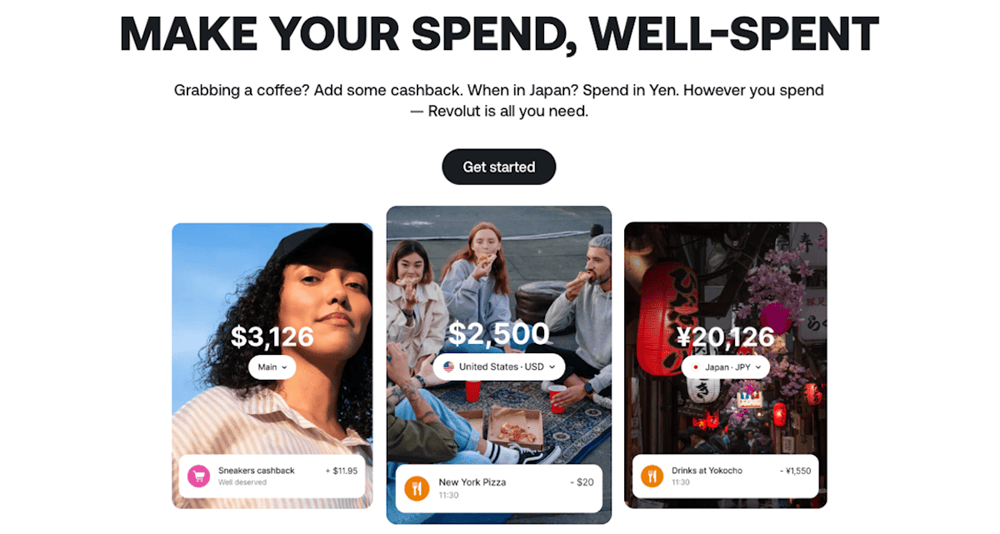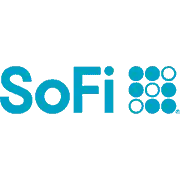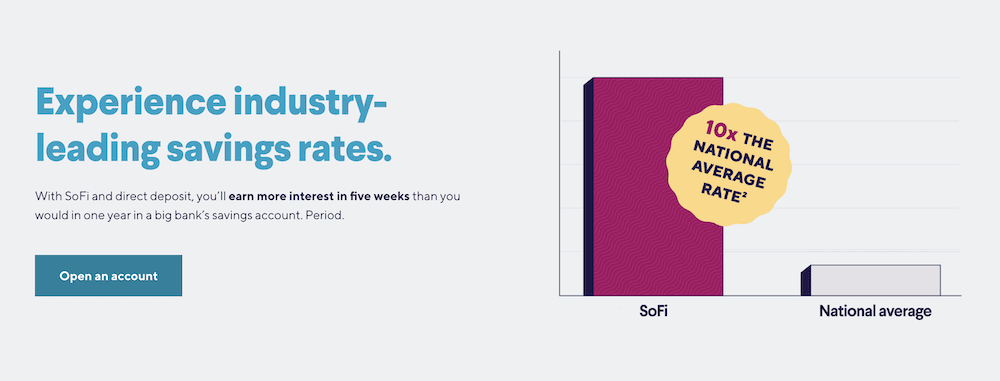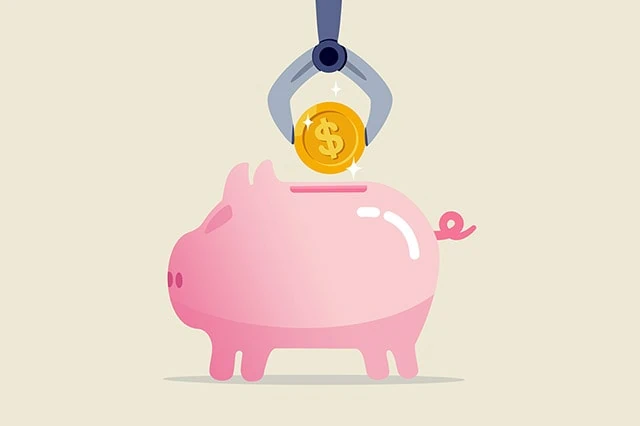Microsavings Apps—Our Top Picks
|
4.1
|
3.6
|
3.9
|
|
Free (no monthly fees).
|
Personal: $3/mo. Personal Plus: $5/mo. Premium: $9/mo.
|
Standard: No monthly fees. Premium: $9.99/mo. Metal: $16.99/mo.
|
Best Microsavings Apps and Accounts
1. SoFi Checking and Savings Account (Up to $300 in Free Cash)
- Available: Sign up here
- Price: Free (no monthly fees)
- Platforms: Web, mobile app (iOS, Android)
The SoFi Checking and Savings Account sounds like your run-of-the-mill bank account, but it’s more: It’s also a high-yield savings account that earns 10 times the national average percentage yield (APY) and more than the average high-yield account. Better still, it boosts your ability to save right off the bat by rewarding you with $50 to $300 upon sign-up.
Sofi Checking and Savings covers all of the basics: No monthly account fees, no minimum balances, and website and mobile app access. But it also has several perks that match or top the competition. Features include:
- Early paycheck reception when you sign up for direct deposit
- FDIC insurance of up to $2 million (vs. $250,000 for most bank accounts)
- Up to 15% cash back when you spend with local retailers
- No-fee overdraft coverage up to $50
- Round-ups on debit card purchases, which are deposited into your savings “Vault”
And right now, you can get a head-start on your savings with qualifying direct deposits. You’ll receive $50 in bonus cash if $1,000.00 to $4,999.99 is sent to your bank account within a 25-day period, starting from when you receive the first direct deposit. That number jumps to $300 when you receive $5,000 or more. The higher cash bonus requires you to hit an admittedly high threshold, but the $50 is a reasonable bonus for a much more manageable threshold.
Want to get started on your cash bonus? Sign up with SoFi today.
- SoFi's Checking and Savings Account is a free, no-monthly fee account that offers an above-average yield on the savings side, and up to 15% cash back when using your checking account's debit card.
- SoFi's high-yield savings account currently pays 4.30% APY, which is 10x the national average savings rate, and higher than the average high-yield rate.
- Available FDIC insurance of up to $2 million is 8x the typical insured amount at most financial institutions.*
- Round up debit card purchases, and the excess is automatically sent to your savings Vault.
- Special Offer: If you set up a qualifying direct deposit within the promotion period, you can earn up to a $300 cash bonus.**
- No account fees
- Above-average yield (4.60% APY) on its high-yield savings account
- Offers up to $50 of overdraft coverage with minimum monthly direct deposits in place
- Round-ups
- Up to $2 million in FDIC insurance
- Not as competitive yield as other banking institutions
- High direct deposit threshold for maximum cash bonus
2. Acorns (Best for Using Round-Ups to Invest)
- Available: Sign up here
- Price: Acorns Personal: $3/mo. Acorns Personal Plus: $5/mo. Acorns Premium: $9/mo.
- Platforms: Web, mobile app (Apple iOS, Android)
Acorns is a micro-investing app geared toward minors, young adults and millennials by offering Round-Ups: The app rounds up purchases made on linked debit and credit cards to the nearest dollar, investing the difference on your behalf.
For example, if you purchase a coffee for $2.60 on a linked credit card, Acorns automatically rounds this charge up to $3.00 and puts the 40-cent difference aside. Once those Round-Ups reach at least $5, they can be transferred to your Acorns account to be invested. You can also invest your Round-Ups more quickly with the Acorns Visa debit card—any time you swipe, your spare change is immediately invested, rather than waiting for your Round-Ups to reach the $5 threshold.
You can also choose to amplify your Round-Ups with the Multiplier feature, which allows you to multiply your Round-Ups investments by 2x, 3x, or 10x. And not sure what to do if the transaction is an even dollar amount? (Say, $1.00 or $2.00.) Whole-Dollar Round-Ups let you select how much to round up whenever this happens.
The Acorns investment offering itself is a simple, automated platform that uses pre-built portfolios of ETFs to keep investors exposed to stocks and bonds. While it doesn’t have much to offer intermediate investors who want variety in their portfolios, Acorns’ basic approach makes it one of the best investment apps for beginners.
Learn more in our Acorns review or sign up today.
- Acorns allows you to sign up for investment, retirement, and checking accounts for you and your family, learn how to earn more money, and grow your investing knowledge.
- Famous for investing spare change automatically through Round-Ups, this all-in-one financial app helps younger generations start investing earlier.
- Invest in expert-built portfolios made up of diversified ETFs.
- Silver tier includes perks such as a 25% match on Acorns Earn rewards (up to $200/mo.), generous APYs on Checking and Emergency Fund, and live Q&As with investing experts.
- Gold tier includes perks such as a 50% match on Acorns Earn rewards (up to $200/mo.), $10,000 in life insurance, picking individual stocks for your portfolio, a free Acorns Early account, and Acorns Early Invest custodial accounts for children with 1% contribution matches.
- Earn even more with Later Match: Acorns will match up to 1% (Silver) or 3% (Gold) of all new IRA contributions in your first year.*
- Special offer: Get a free $20 bonus investment when you sign up with our link and start making recurring investments.**
- Robo-advisor with affordable fees (on larger portfolios)
- Fixed fee model
- Round-ups
- FDIC/SIPC insurance
- IRA match (Personal Plus and Premium)
- High fixed fees for small balances
- Limited investment selections
- Must subscribe to Premium for any self-directed investing options
3. Revolut (Capable App for Many Money Needs)

- Available: Sign up here
- Price: Standard: No monthly fees. Premium: $9.99/mo. Metal: $16.99/mo.
- Platforms: Mobile app (Apple iOS, Android)
Revolut is a financial technology company that helps customers save money in several ways, offering payment tools, a prepaid debit card, currency exchange, investing… and, of course, savings.
Like many other financial apps, Revolut lets you make one-time deposits or set up recurring transfers to your Savings Vault, where you keep your savings. You can add money to a Revolut account in numerous ways, including bank transfer, debit card, Apple Pay or Google Pay, direct deposit, even transfers from other Revolut customers. You can also round-up purchases and have the spare change dropped into your Savings Vault.
You can withdraw money any time, quickly and at no cost from 55,000 in-network ATMs. Just note that Revolut limits out-of-network ATM withdrawals at up to $1,200 per month, and third party fees may apply.
Revolut offers other useful money-related features as well, such as the ability to get paid up to two days early*, Group Bills (to split costs), discounts, cash-back rewards on certain brands, discounted airport lounge access (Premium and Metal plans only), and more.
- Spend, save, invest, and more with Revolut—a financial app that simplifies your money.
- All plans come with a personalized Revolut prepaid debit card, unlimited single-use virtual cards for safer online shopping, no-fee currency exchange, and no-fee withdrawals at more than 55,000 in-network ATMs.
- You can save by yourself or even with family and friends in the Revolut Vault: a savings product that offers a 2.75% APY (or 3.5% for Premium and Metal users).
- Trade stocks and ETFs with no commissions with as little as $1, or invest in a robo-curated diversified portfolio for 0.25% annually (with a monthly minimum fee of 25¢.
- Special offer: Get a $10 bonus by opening a Revolut account and making your first virtual or physical Revolut card payment.
- 55,000+ no-fee in-network ATMs
- Direct deposit
- Early salary*
- International/foreign currency benefits
- Round-ups
- Ticket protection, returns protection, accidental medical insurance, and other perks with Metal subscription
- FDIC insurance
- 24/7 live chat support
- High fees for paid tiers
- Must subscribe to a paid plan for highest savings APY
- Phone support is automated only
Best Microsavings Apps
No one ever saved a dime by wishing, dreaming, hoping, or thinking they could set some money aside. The only way you’ll ever get to saving is to jump in and do it.
Easier said than done, of course. That’s why so many of us who do have the means to save still can’t manage to make a meaningful dent in our savings goals. So, if you find yourself thinking “I’d like to save more,” my advice would be to consider a small step that can snowball into big results.
That small step, of course, is trying out a microsavings app. Microsavings apps can work in several different ways, but the general idea is roughly the same—they help you save automatically. No thinking. No procrastinating. No postponing. Just saving.
This article introduces you to some of the best microsavings apps I’ve tested out. Rather than trying to make a big splash into saving, they help you gradually ease into the habit—and as you get more comfortable, they help you accelerate your savings until you finally reach your financial goals.
As I walked you through the best money-saving apps, I showed you their best features, downsides, and any other considerations you’ll need to make before trying one (or more) out. Now, I’ll ask a few frequently asked questions about microsaving apps, and saving in general.
What Is a Microsavings App?
Microsavings apps make saving money easier. Think of them as automatic savings apps that help users set aside money in small increments to build toward bigger goals.
How Microsavings Apps Work
The various money-saving apps out there might all seem alike at a quick glance. But when you dig down deep, you’ll see that they all have their own proprietary blends of herbs and spices that not only whip your savings into shape—but often help enhance other areas of your financial life.
Still, you’re bound to see some similarities. Among the most popular features you’ll tend to see among the different microsavings apps:
- Round-ups (Purchases are rounded up to the nearest dollar, and the “spare change” is deposited into a savings or investment account)
- Self-tipping (Similar to round-ups, you select an amount of money to pay yourself—and deposit into your savings account—every time you spend)
- Saving matches
- Cash-back rewards
- Interest on account balances
- Automatic transfers from spending accounts to savings
- Educational resources
- Other features that promote good savings habits
A microsavings app might use just one or several of the features highlighted above. But the end goal is the same: help you save regularly, automatically, in manageable chunks.
Also, while many money-saving apps funnel your money into a savings account, some help you use your savings to fund investment accounts so you can grow that money.
Why Use a Microsavings App?
Microsavings apps are useful to people who have trouble saving, but also to those who excel at saving.
If you forget to save or just never feel motivated enough to manually put money away, microsavings apps can take the bricks off your shoulders. They can help you automatically put part of your paycheck away each month, or help you turn every purchase into an opportunity to save a bit at a time.
And if you’re an experienced saver, microsavings apps can help you accelerate what you’re already doing, whether that’s through round-ups, cash-back rewards, interest, or other savings-amplifying features.
Benefits of Using a Microsavings App
Automatic savings apps …
- Build saving habits. Savings should be part of your monthly budget—not an afterthought.
- Help you grow your savings over time. Even small amounts of money, built up and grown (whether by investing it, collecting interest on it, or enjoying savings matches on it) help build a large nest egg over time.
- Save time and reduce stress. The better money savings apps out there help automate all sorts of saving processes.
- Keep your savings separate from other financial buckets. People who try to save money within the same account they spend from have a more difficult time tracking how much they’re actually saving, and face greater temptation to withdraw saved funds.
Who Might Consider Using a Microsavings App?
- Aspiring savers who want to find concrete ways to stop spending their entire paycheck.
- Financial novices who are just starting their savings journey—regardless of age.
- Anyone who feels overwhelmed by their finances and wants but knows saving is important.
- Experienced savers who want to squeeze more money out of their financial transactions.
Considerations When Reviewing Microsavings Apps
- Fees: Try to avoid microsaving apps with monthly fees, or other costly fees, unless the features justify the cost.
- Minimum balance requirement: Don’t choose a money app with a minimum balance requirement unless you are confident you would never need to dip below the minimum.
- Interest rate/APY: The higher the interest rate or yield, the more earning potential available.
- Savings rules/features: Does the app offer round-ups? Automatic transfers? Cash-back rewards? The more ways an app can help you save, the better.
- Number of accounts or savings goals: I can’t speak for everyone, but I will say that most people can benefit from having multiple accounts to make sure money ends up going toward what it was originally earmarked for. At the very least, you should have one checking/spending account and one savings account. Some people prefer having multiple savings accounts to keep their money siloed for different purposes.
- Insurance: FDIC and National Credit Union Association (NCUA) insurance helps protect funds in bank accounts and other banking products against the possibility of the bank going under. SIPC insurance acts similarly, but applies to investment institutions, such as stock brokers.
- Investment options: If you care about having the ability to invest within your savings app, make sure you have access to the assets you want. If you want to invest in stocks you choose, but the app only has pre-built ETF portfolios, look elsewhere.
Disclosures
Revolut
* Early salary subject to employer deposit timing and not guaranteed.
Revolut is not a bank, banking services are provided by Lead Bank, Member FDIC. Fees may apply. The Revolut USA Prepaid Visa and Prepaid Mastercard are issued by Lead Bank pursuant to licensing by Visa® U.S.A. Inc. and Mastercard International for Mastercard cards. Funds in your Revolut Prepaid Card Account are held at or transferred to Lead Bank, Member FDIC, and are insured by the FDIC up to $250,000 applicable limits by the FDIC in the event Lead Bank fails if specific deposit insurance requirements are met. See FDIC-Prepaid Cards and Deposit Insurance Coverage
Securities products and services provided by Revolut Securities Inc., member FINRA/SIPC. Securities products are not insured by the FDIC or any federal government agency, are not bank deposits, are not obligations of or guaranteed by any bank and are subject to investment risks, including possible loss of the principal amount invested.Automated investing is provided by Revolut Wealth Inc., an SEC registered investment advisor. Information about operations, services, and fees is set forth in Revolut Wealth’s current Form ADV Part 2 (Brochure), a copy of which is available upon request and at IAPD – Investment Adviser Public Disclosure – Homepage.
Bonus Terms & Conditions: https://www.revolut.com/en-US/legal/partner-sign-up-bonus/









